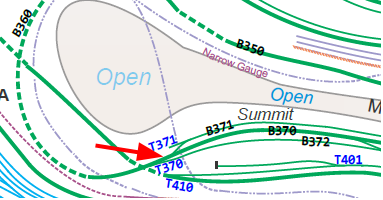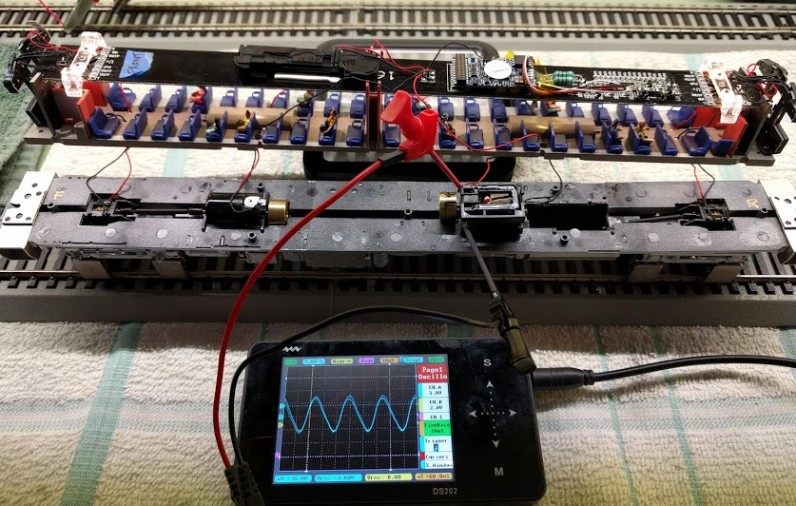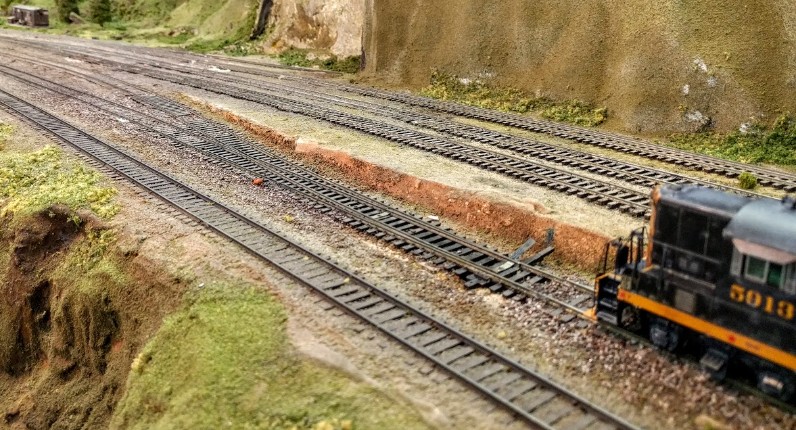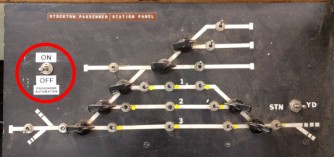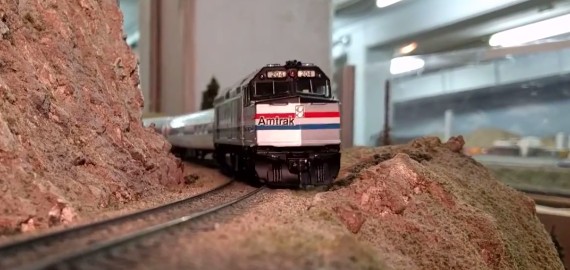The Randall Museum in San Francisco hosts a large HO-scale model model railroad. Created by the Golden Gate Model Railroad Club starting in 1961, the layout was donated to the Museum in 2015. Since then I have started automatizing trains running on the layout. I am also the model railroad maintainer. This blog describes various updates on the Randall project and I maintain a separate blog for all my electronics not directly related to Randall.
Affected |
Turnout T370 + T371 (between bridge and signal bridge on Summit). |
Description |
Cold joint at junction between B360 and T370. |
Summary Fix |
Bond wire around B370 and T370 rail (engineer side). |
Description of Issue
Reports of trains stopping on turnouts T370 / T371, between bridge and signal on Summit.
Tried running two engines (GP9 5913, F40PH 506 from automation) and easily encountered the issue.
Measured voltage when engine stops: there was none.
Pushing the rails or the points (even so slightly with the voltmeter) immediately fixed the issue.
Click here to continue reading...
2018-06-16 - RDC is back (soon)
Category RandallAfter what took like forever, the Randall’s RDC engine is finally working again. This is what it looks like:
You’d be right to ask “what the heck am I looking at here?!!”. Very fair to ask. You are looking at a Rapido RDC SP 10 disassembled, with the motors being in the process of being replaced.
Let make me this clear: if your Rapido RDC stops running, save yourself some trouble. Contact Rapido’s support, and ask them to fix it for you. You’ll save yourself a lot of trouble.
Click here to continue reading...
Affected |
Turnout T05 (Stockton Front Yard). Turnout toggle button. |
Description |
Trains stop on turnout / short the block after. Examination indicate frog has wrong polarity when T05 is Normal. |
Summary Fix |
Spring fallen in the Fulgurex contact that reverses the frog polarity. |
Description of Issue
There are two totally unrelated issues that make turnout T05 hard to use. Make that three issues.
Toggle button issues:
- Turnout toggle button is loose. It rotates.
- Turnout toggle button is a 3-position and not a 2-position.
Frog issue: Second issue is an incorrect polarity on the T05 frog.
T05 is a double cross-over. When straight, the frog in mainline track 1 tested as having the same polarity as the lower rail.
What should be expected:
- There’s supposed to be a gap between the track 1 & track 2 segment cross-overs.
- The frog is controlled by a Fulgurex to draw power from either rail A or B.
Click here to continue reading...
2018-03-30 - Doodlebug
Category RandallHere’s an interesting experiment for the Branchline automation: using a Doodlebug.
This one comes courtesy of Martin Perry, who bought the Doodlebug and coach back in the 2000s. In 2005, he relettered both cars and donated them to the GGMRC for the Branchline operation, so it would be quite fitting to have it run today on the branchline automation. The engine is part of Bachmann’s Spectrum line and ten years later still works like a charm.
Since I have no record of when maintenance was done on it, I should probably open it and lubricate it before using it for daily automation. Right now it’s on “probation” to make sure it works and does not derail on the branchline dual-gauge turnouts… these have been doing fine so far but I’ve had some not-so-great experience running a previous 2-6-0 engine right there a couple years ago.
2018-03-28 - Error Conditions
Category RandallNow that we have some basic automation running and, most importantly, some feedback on how it is running, it’s time to account for error conditions. The post from 2018-02-12 did mention that earlier but it was more academic with any actual basis. Now I do have basis:
- On the Branchline, a repeated issue is the RDC failing to stop and reverse on the reverse block.
- Now that the RDC is moved to the mainline, I did experience the same issue at least once. However that’s not clear cut as in this instance I was also trying to update/restart RTAC remotely. It happened in a second instance for the RDC.
- At least once the same issue happened with the Amtrak train.
That picture is, ironically, exactly what I want to avoid and which happened:
In trains parlance, this is called a runaway.
Click here to continue reading...
So it’s the beginning of January 2018, I am being told the museum opens in one month and I have two engines that are constantly derailing. Not a good way to demonstrate that automated train layout that I’ve been working on for the last 2 years (or at least trying to, when I had access).
Logical plan: have backups. Nothing new, I had mentioned this multiple times in the past. In an effort to move on towards that goal, I got hold of some of the previous GGMRC-owned engines appropriate for the task, namely three P42 and three GE Dash 8-32BWH. The P42s seem in dubious shape, having run quite a lot.
The three GEs seemed better. One was still DC and two had their original Atlas decoders and seemed to run adequately. These are from the Atlas Master line, and came equipped with dual DC/DCC decoders.
After some lubrication (and learning the hard way how to take the shells off) followed by basic speed matching, two GE Dash 8-32BWH are used in the automation program and we get through the Randall Museum’s Reopening Ceremony fairly well, including two follow up Saturday.
The third Saturday is the Science Fair exhibit at the museum. Very large attendance. Record on the RTAC tablets show that the branchline RDC ran 120 times (!) and the Amtrak train ran 45 times.
And by the end of the day one of the engines stalls on some turnouts.
I take both engines home, remove the shell and realize that one of the motor is… smoking :-/
Click here to continue reading...
2018-02-24 - Mainline Issues
Category RandallRunning under automation is only one aspect for the train model railroad on the Randall Museum.
The other aspect is supporting people who want to run on Saturdays. There are a few challenges to solve here, such as complying with museum requirements and defining our own screening and approval process. That could be tricky since ex-members might want to run as if they were back in their old club, using their old ways.
One point I have been trying to make is that running on this layout is more tricky than it looks. The panels are confusing, labeled yet hard to understand. Most people have the natural bias of overestimating their own proficiency and that is clearly visible when operating this layout. That is why I want to insist in everyone, including ex-members, in having a training before running again yet at the same time there’s little traction for it from said people -- the typical “how hard can it be”.
But before getting there, one issue to address is the lack of maintenance on the mainline.
5913 approaches turnout T322. The point was stuck and throwing it shorted the mainline.
Click here to continue reading...
2018-02-18 - Automation Toggles
Category RandallNow that the barrier is up, the automation toggles are hard to reach.
The original design goal was that operators can quickly look whether the toggles are physically up or down, and being able to easily flip with up or down. So having them in a central location made a lot of sense. During the renovation, we used to work in the middle area and have direct access to the mountain panel. Now we don't.
Passenger Automation |
Branchline Automation |
What would make sense now is to have them in the valley panel area.
Another choice is to have both, e.g 3 state toggles (off, rest, on), repeated on both panels. Push up for on, down for off. The computer keeps the state. By then at that point, we might as well not have physical toggles and move the control to the tablet. The “downside” is that it makes the tablet indispensable for the automation, which is a big no-no.
Issues noted during the Randall Opening Day:
- Passenger:
- One derailment from 204 going down on B320 between the signal bridge and the turnout.
- Two derailments from 209 going up right when leaving the station. This is again a very very subtle left turn.
- Branchline:
- About 4~5 times, the RDC stopped at a station and never left again. One time it missed the stop at the reverse station.
- 2 times we couldn’t figure where it was.
To deal with the Passenger train issue leaving the station: this happens where the train accelerates and there’s a very very slightly left curve. ⇒ Delay the acceleration till the train is in the straight line after, which leads to a right curve.
Click here to continue reading...
2018-02-01 - Rapido F40PH
Category RandallThe main passenger automation runs using two new Rapido F40PH engines. They have superb detail and superb sound.
Since we use them for the automation in a back-and-forth route, our initial concern was that some dirty track where the engine stops and reverse would have them lose power. Thus we got two ESU current keeper which I installed.
Many weeks pass and I finally complete the automation of the route. At first everything is fine and then we realize quickly that one engine derails consistently in one of the curves, just before the canyon bridge by the entrance.
Oddly enough we have seen hundreds of engines go through that route, and even though the layout track is not exactly new, it does seem OK.
Click here to continue reading...
